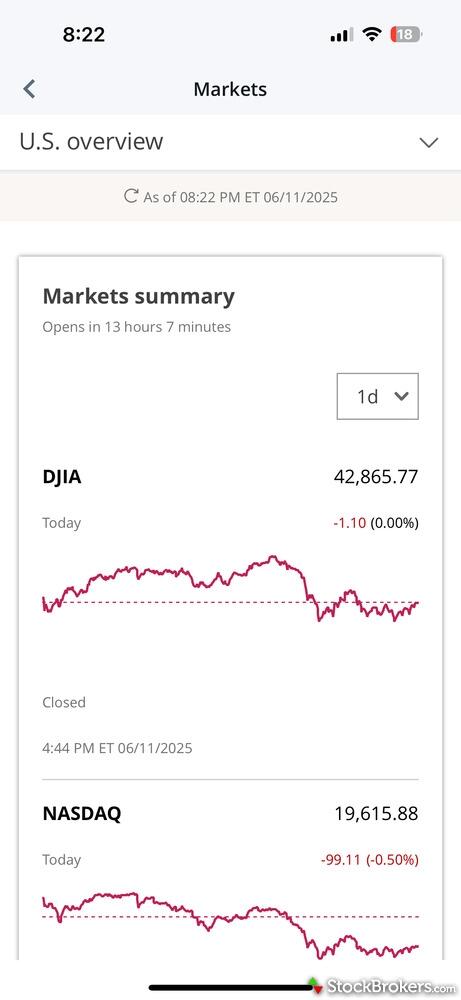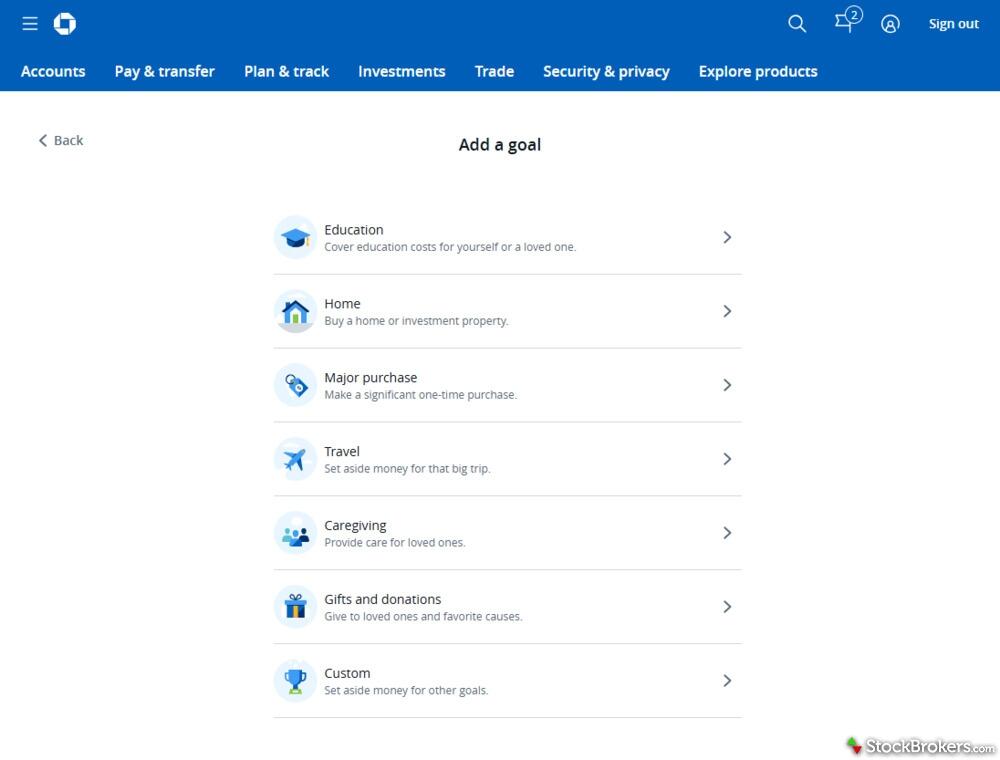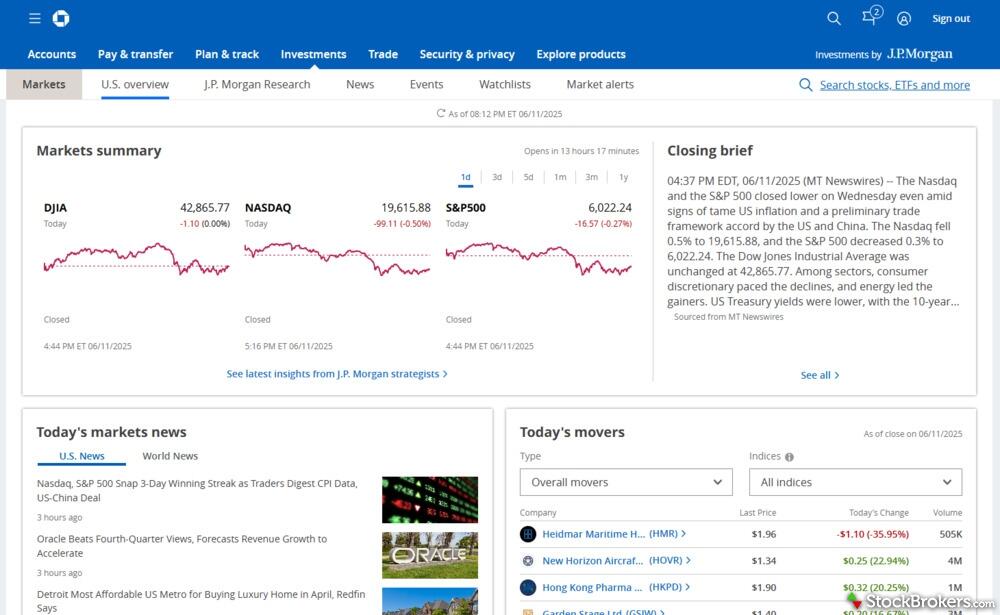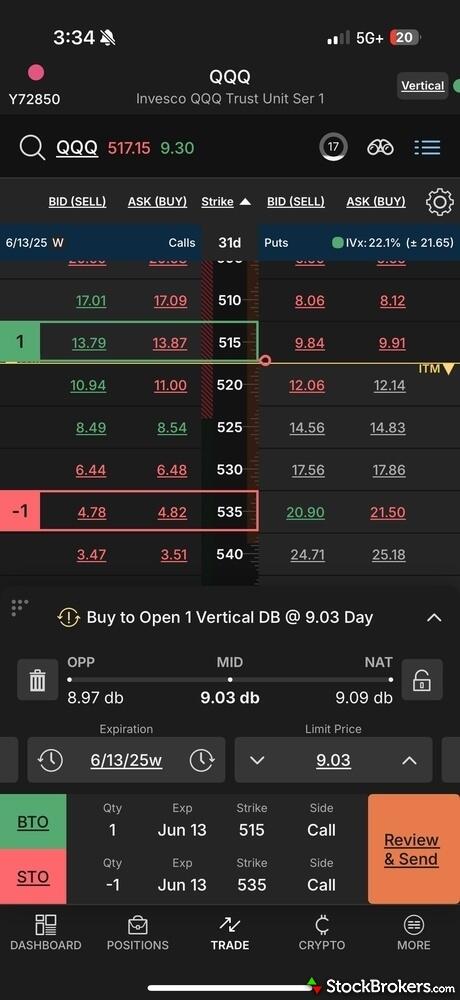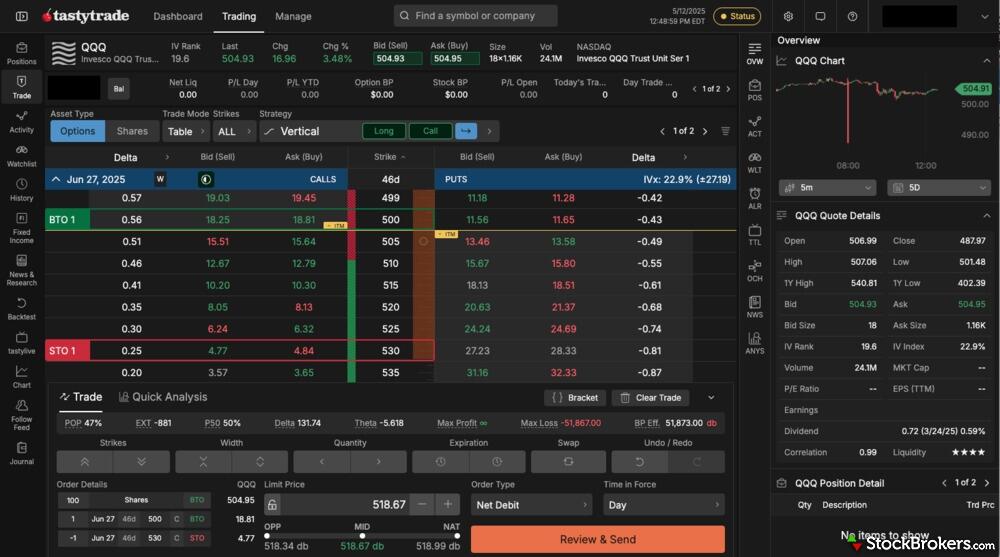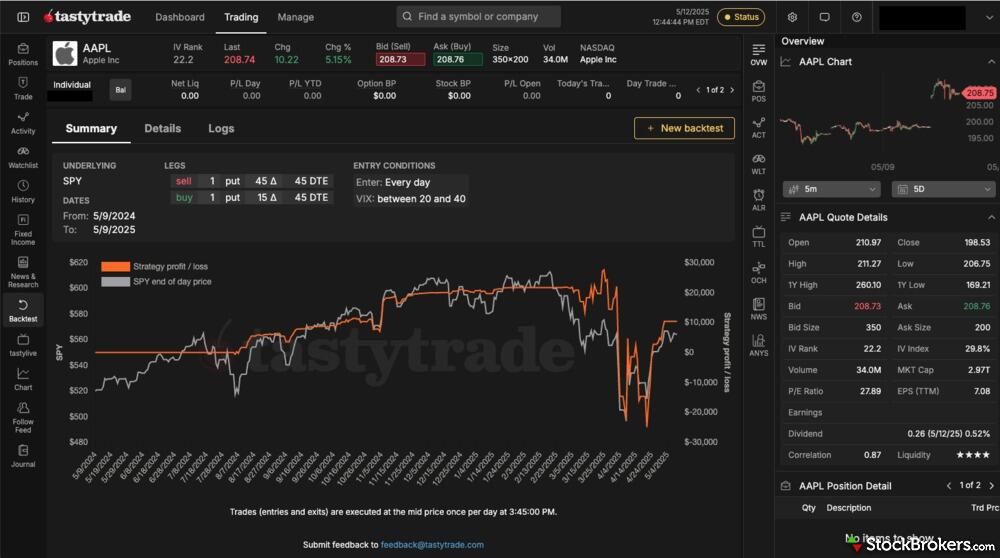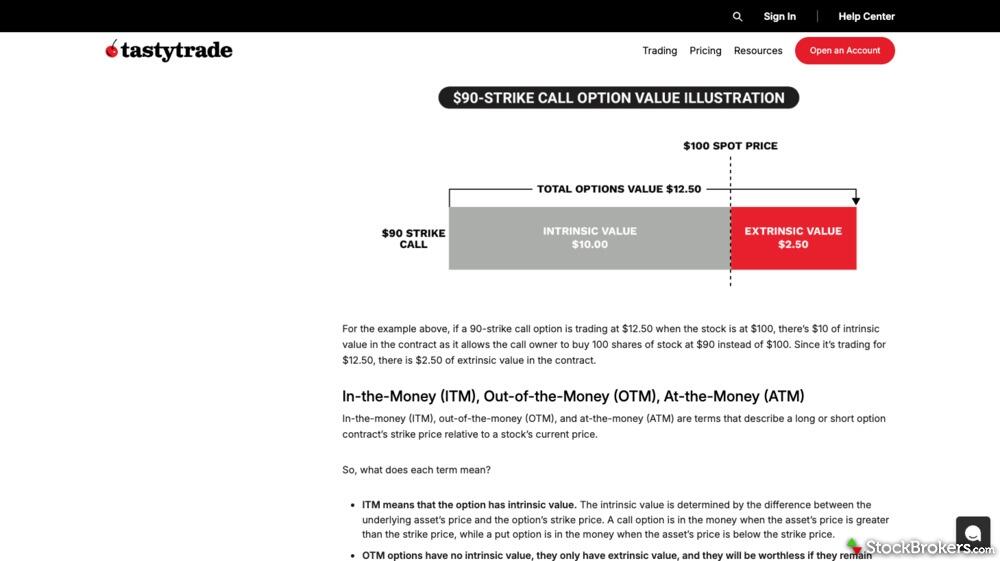Range of investments
Bottom line: Choose J.P. Morgan Self-Directed Investing if you want a traditional menu with mutual funds, OTC stocks, and access to advisor services. Pick tastytrade if you want a platform built around active trading in options, forex, futures, and crypto. Both brokers support stocks, options, margin, fractional shares, and Traditional and Roth IRAs. Each earns 4 stars for Range of Investments from StockBrokers.com, with J.P. Morgan ranked #9 and tastytrade #10 out of 14 brokers.
J.P. Morgan Self-Directed Investing covers core needs: stock trading, options, margin, and fractional shares. It also offers OTC stocks and mutual funds—two areas tastytrade does not support—plus Traditional and Roth IRAs and advisor services. It does not offer forex, futures, or crypto trading (0 coins).
tastytrade matches the basics—stocks, options, margin, and fractional shares—and expands into forex, futures, and crypto trading with 17 coins available. It also supports Traditional and Roth IRAs. However, it does not offer OTC stocks, mutual funds, or advisor services.
|
Feature |
 J.P. Morgan Self-Directed Investing J.P. Morgan Self-Directed Investing
|
 tastytrade tastytrade
|
|
Stock Trading
info
|
Yes
|
Yes
|
|
Account Feature - Margin Trading
info
|
Yes
info |
Yes
|
|
Fractional Shares (Stocks)
info
|
Yes
|
Yes
info |
|
OTC Stocks
info
|
Yes
|
No
|
|
Mutual Funds
info
|
Yes
|
No
|
|
Options Trading
info
|
Yes
|
Yes
|
|
Futures Trading
info
|
No
|
Yes
|
|
Crypto Trading
info
|
No
|
Yes
|
|
Crypto Trading - Total Coins
info
|
0
|
17
|
|
Range of Investments
|

|

|
Dive deeper: Best Options Trading Platforms for 2025, Best Futures Trading Platforms for 2025: A Beginner-Friendly Guide to an Advanced Market
Trading platforms and tools
Bottom line: For traders who want feature-rich charting and a full desktop platform, tastytrade is the stronger choice. It offers far more chart tools and customization and is rated 4 stars for trading platforms and tools, ranked #8 of 14 by StockBrokers.com. J.P. Morgan Self-Directed Investing suits basic web trading but trails in analytics and workflow, earning 2.5 stars and ranking #13 of 14.
Platform access and core tools differ notably. tastytrade provides downloadable desktop platforms for both Windows and Mac, plus a browser-based platform; J.P. Morgan Self-Directed Investing is browser-only. Neither broker offers paper trading, but tastytrade includes a trading journal (J.P. Morgan does not). For watchlists, tastytrade supports up to 33 data columns, while J.P. Morgan offers 20.
Charting and analysis tilt heavily toward tastytrade. It supplies 308 technical indicators (vs. 36), 31 drawing tools (vs. 10), and lets you adjust open orders on charts, add notes, and display historical trades—features J.P. Morgan lacks. Both show corporate events on charts, but tastytrade also supports custom date ranges, saving multiple chart profiles, deeper SMA editing (7 fields vs. 3), and even creating custom studies. Automated chart pattern detection is unavailable on both. Choose tastytrade if you value advanced charting and customization; pick J.P. Morgan Self-Directed Investing if simple, browser-based trading is enough.
|
Feature |
 J.P. Morgan Self-Directed Investing J.P. Morgan Self-Directed Investing
|
 tastytrade tastytrade
|
|
Web Trading Platform
info
|
Yes
|
Yes
|
|
Desktop Trading Platform
info
|
No
|
Yes
|
|
Desktop Platform (Mac)
info
|
No
|
Yes
|
|
Paper Trading
info
|
No
|
No
|
|
Watchlists - Total Fields
info
|
20
|
33
|
|
Charting - Indicators / Studies
info
|
36
|
308
|
|
Charting - Drawing Tools
info
|
10
|
31
|
|
Platforms & Tools
|

|

|
Dive deeper: Best Trading Platforms for 2025, Best Paper Trading Apps & Platforms for 2025
Trade brilliantly with Schwab.
A full-featured account for investing
Get up to $1K on new brokerage account*
Beginners and education
J.P. Morgan Self-Directed Investing and tastytrade both support beginners with stock, ETF, and options education, plus educational videos and webinars. If you want mutual fund or bond education, J.P. Morgan is the better fit, as tastytrade does not cover those topics. Neither offers paper trading or quizzes. Only tastytrade lets you track your learning progress inside the platform.
For overall education, J.P. Morgan Self-Directed Investing is rated 4.5 out of 5 stars and ranks #6 of 14 brokers on StockBrokers.com, while tastytrade is rated 4 out of 5 stars and ranks #9 of 14. Choose tastytrade if progress tracking matters most; pick J.P. Morgan Self-Directed Investing if you want broader topic coverage and a higher-rated education experience.
|
Feature |
 J.P. Morgan Self-Directed Investing J.P. Morgan Self-Directed Investing
|
 tastytrade tastytrade
|
|
Education (Stocks)
info
|
Yes
|
Yes
|
|
Education (ETFs)
info
|
Yes
|
Yes
|
|
Education (Options)
info
|
Yes
|
Yes
|
|
Education (Mutual Funds)
info
|
Yes
|
No
|
|
Education (Fixed Income)
info
|
Yes
|
No
|
|
Paper Trading
info
|
No
|
No
|
|
Videos
info
|
Yes
|
Yes
|
|
Webinars
info
|
Yes
|
Yes
|
|
Education
|

|

|
Dive deeper: Best Stock Trading Platforms for Beginners of 2025
Stock trading apps
Bottom line: both J.P. Morgan Self-Directed Investing and tastytrade deliver capable stock trading apps for iPhone and Android, but they shine in different ways. tastytrade earns the higher app rating (4.5 stars, ranked #10 of 14 by StockBrokers.com) with streaming quotes and after-hours charting. J.P. Morgan Self-Directed Investing scores 4 stars (ranked #12) and stands out for traders who want more built-in indicators. If real-time quotes and extended-hours chart views matter most, tastytrade is the pick; if you rely on technical studies, J.P. Morgan’s app is the better fit.
Both brokers offer iPhone and Android apps and do not support Apple Watch. Each app includes mobile options trading, stock alerts, custom watch lists, and watch list column customization. Neither platform provides streaming live TV or videos on demand.
For market data and charts, tastytrade supplies streaming quotes and supports after-hours charting, while J.P. Morgan Self-Directed Investing does not. Charting flexibility is similar in other areas: both allow landscape mode and multiple time frames, and neither supports side-by-side stock comparisons on charts. The big split is technical studies: J.P. Morgan Self-Directed Investing offers 36 studies in its mobile app, whereas tastytrade offers none.
|
Feature |
 J.P. Morgan Self-Directed Investing J.P. Morgan Self-Directed Investing
|
 tastytrade tastytrade
|
|
iPhone App
info
|
Yes
|
Yes
|
|
Android App
info
|
Yes
|
Yes
|
|
Apple Watch App
info
|
No
|
No
|
|
Stock Alerts
info
|
Yes
|
Yes
|
|
Charting - After-Hours
info
|
No
|
Yes
|
|
Charting - Technical Studies
info
|
36
|
0
|
|
Mobile Trading Apps
|

|

|
Dive deeper: Best Stock Trading Apps for 2025
Fees
Here’s the quick takeaway: Both J.P. Morgan Self-Directed Investing and tastytrade offer $0 account minimums and $0 commissions for online stock trades. tastytrade generally costs less for options contracts ($0.50 vs. $0.65) and has lower margin rates across common balance tiers. J.P. Morgan Self-Directed Investing stands out with $0 fees for options exercise and assignment (tastytrade charges $5 each) and charges $0 for partial account transfers, while tastytrade’s IRA closure fee is lower ($60 vs. $75). Full account transfers cost $75 at both brokers, and both have $0 IRA annual fees.
Trading fees are straightforward: minimum deposit is $0.00 at both brokers, and stock trades are commission-free. For options, J.P. Morgan Self-Directed Investing charges $0.65 per contract, while tastytrade charges $0.50 per contract. If you expect to exercise or be assigned on options, J.P. Morgan Self-Directed Investing has a pricing edge with $0 exercise and assignment fees compared with tastytrade’s $5 per event.
Margin rates are typically lower at tastytrade: below $25,000, it’s 11% vs. J.P. Morgan Self-Directed Investing’s 12.25%; from $25,000 to $49,999, 10.5% vs. 12%; and from $50,000 to $99,999, 10% vs. 11.5%. On account fees, both have $0 IRA annual fees, but IRA closure costs $75 at J.P. Morgan Self-Directed Investing and $60 at tastytrade. For moving your account (ACAT), partial transfers are $0 at J.P. Morgan Self-Directed Investing and $75 at tastytrade, while full transfers are $75 at both.
|
Feature |
 J.P. Morgan Self-Directed Investing J.P. Morgan Self-Directed Investing
|
 tastytrade tastytrade
|
|
Minimum Deposit
info
|
$0.00
|
$0.00
|
|
Stock Trades
info
|
$0.00
|
$0.00
|
|
Options (Per Contract)
info
|
$0.65
|
$0.50
info |
|
Options Exercise Fee
info
|
$0.00
|
$5.00
|
|
Options Assignment Fee
info
|
$0.00
|
$5.00
|
|
IRA Annual Fee
info
|
$0.00
|
$0.00
|
|
IRA Closure Fee
info
|
$75.00
|
$60.00
|
Dive deeper: Best Free Trading Platforms for 2025
Day Trading
For day trading, J.P. Morgan Self-Directed Investing and tastytrade share several gaps: neither offers streaming time and sales, Level 2 quotes, direct market routing, trading hotkeys, basic strategy backtesting, or order liquidity (maker/taker) rebates. These missing tools can matter for traders who rely on faster reads of supply and demand or who want tighter control over order execution.
The key differences favor tastytrade. It adds streaming live TV for market coverage, ladder trading for quick order entry, advanced strategy backtesting to test ideas, and a short locator to check real-time borrow availability—none of which J.P. Morgan Self-Directed provides. If you’re focused on active intraday trading and want these extras, tastytrade is the better fit; if you just need straightforward stock trades tied to your banking, J.P. Morgan Self-Directed Investing can work.
|
Feature |
 J.P. Morgan Self-Directed Investing J.P. Morgan Self-Directed Investing
|
 tastytrade tastytrade
|
|
Streaming Time & Sales
info
|
No
|
No
|
|
Streaming TV
info
|
No
|
Yes
|
|
Direct Market Routing - Equities
info
|
No
|
No
|
|
Level 2 Quotes - Stocks
info
|
No
|
No
|
|
Trade Ideas - Backtesting
info
|
No
|
No
|
|
Trade Ideas - Backtesting Adv
info
|
No
|
Yes
|
|
Short Locator
info
|
No
|
Yes
|
Dive deeper: Best Day Trading Platforms of 2025 for Beginners and Active Traders
Market Research
Bottom line: for market research, J.P. Morgan Self-Directed Investing clearly outpaces tastytrade. J.P. Morgan earns 4 out of 5 stars and ranks #7 of 14 brokers at StockBrokers.com, while tastytrade scores 1.5 stars and ranks #13. If you want wider asset coverage and more ways to dig into ideas, J.P. Morgan is the stronger pick. If you only need basic stock and ETF research, tastytrade can suffice.
Both brokers supply stock and ETF research and let you view your portfolio allocation by asset class. J.P. Morgan goes further with mutual fund, bond, and Pink Sheets/OTC research—areas tastytrade does not cover. J.P. Morgan also offers two downloadable PDF stock reports; tastytrade offers none. Neither broker provides downloadable ETF or mutual fund reports, ESG research, or social media sentiment tools.
When it comes to finding trade ideas, both platforms include stock and ETF screeners. J.P. Morgan adds screeners for mutual funds and bonds, while tastytrade offers a bond screener but no mutual fund screener. The added coverage and tools at J.P. Morgan help explain its higher rating and better ranking for research.
|
Feature |
 J.P. Morgan Self-Directed Investing J.P. Morgan Self-Directed Investing
|
 tastytrade tastytrade
|
|
Research - Stocks
info
|
Yes
|
Yes
|
|
Screener - Stocks
info
|
Yes
|
Yes
|
|
Research - ETFs
info
|
Yes
|
Yes
|
|
Screener - ETFs
info
|
Yes
|
Yes
|
|
Research - Mutual Funds
info
|
Yes
|
No
|
|
Screener - Mutual Funds
info
|
Yes
|
No
|
|
Research - Fixed Income
info
|
Yes
|
No
|
|
Screener - Fixed Income
info
|
Yes
|
Yes
|
|
Research
|

|

|
Banking
When comparing the banking features of J.P. Morgan Self-Directed Investing and tastytrade, J.P. Morgan clearly stands out with a comprehensive suite of offerings. J.P. Morgan Self-Directed Investing provides users with access to checking accounts, savings accounts, debit cards, and credit cards. Additionally, those who use J.P. Morgan can benefit from mortgage loans and certificates of deposit (CDs), making it a versatile choice for individuals seeking a wide range of financial services. On the other hand, tastytrade does not offer any of these banking features, focusing solely on trading platforms without the added conveniences offered by J.P. Morgan. For users who wish to integrate their investment platform with everyday banking needs, J.P. Morgan Self-Directed Investing offers a far more complete financial solution.
Dive deeper: Best Brokerage Checking Accounts for 2025
Winner
After opening live accounts and testing 14 of the best online brokers, our research and live account testing finds that J.P. Morgan Self-Directed Investing is better than tastytrade. J.P. Morgan Self-Directed Investing finished with an overall score of 85.4%, while tastytrade finished with a score of 80.1%.
J.P. Morgan Self-Directed Investing makes it easy for Chase Bank customers to invest and allows access to J.P. Morgan research. On the downside, the broker features are sparse compared to industry leaders.
FAQs
Can you trade cryptocurrency with J.P. Morgan Self-Directed Investing or tastytrade?
J.P. Morgan Self-Directed Investing does not offer crypto trading, while tastytrade provides options to trade 17 different cryptocurrencies, making it a better choice for those interested in digital coin investments.
Dive deeper: Best Online Brokers for Crypto Trading in 2025
Does J.P. Morgan Self-Directed Investing or tastytrade offer IRAs?
Both J.P. Morgan Self-Directed Investing and tastytrade offer traditional and Roth IRA accounts with no annual fees; however, J.P. Morgan charges a $75 closure fee, while tastytrade charges a $60 closure fee.
Dive deeper: Best IRA Accounts for 2025
Popular trading guides
More trading guides
Popular broker reviews
navigate_before
navigate_next
|
Broker Screenshots
|
J.P. Morgan Self-Directed Investing |
tastytrade |
|
|
Broker Gallery (click to expand) |
|
|
|
|
Trading Fees
|
J.P. Morgan Self-Directed Investing |
tastytrade |
|
|
Minimum Deposit info
|
$0.00
|
$0.00
|
|
|
Stock Trades info
|
$0.00
|
$0.00
|
|
|
Penny Stock Fees (OTC) info
|
$0.00
|
N/A
|
|
|
Mutual Fund Trade Fee info
|
$0
|
N/A
info
|
|
|
Options (Per Contract) info
|
$0.65
|
$0.50
info
|
|
|
Futures (Per Contract) info
|
(Not offered)
|
$1.00
info
|
|
|
Broker Assisted Trade Fee info
|
Varies
|
$0
|
|
|
Margin Rates
|
J.P. Morgan Self-Directed Investing |
tastytrade |
|
|
Margin Rate Under $25,000 info
|
12.25%
|
11%
|
|
|
Margin Rate $25,000 to $49,999.99 info
|
12%
|
10.5%
|
|
|
Margin Rate $50,000 to $99,999.99 info
|
11.5%
|
10%
|
|
|
Margin Rate $100,000 to $249,999.99 info
|
11.25%
|
9.5%
|
|
|
Margin Rate $250,000 to $499,999.99 info
|
11.25%
|
9%
|
|
|
Margin Rate $500,000 to $999,999.99 info
|
10.5%
|
8.5%
|
|
|
Margin Rate Above $1,000,000 info
|
10%
info
|
8%
|
|
|
Account Fees
|
J.P. Morgan Self-Directed Investing |
tastytrade |
|
|
IRA Annual Fee info
|
$0.00
|
$0.00
|
|
|
IRA Closure Fee info
|
$75.00
|
$60.00
|
|
|
Account Transfer Out (Partial) info
|
$0.00
|
$75.00
|
|
|
Account Transfer Out (Full) info
|
$75.00
|
$75.00
|
|
|
Options Exercise Fee info
|
$0.00
|
$5.00
|
|
|
Options Assignment Fee info
|
$0.00
|
$5.00
|
|
|
Investment Options
|
J.P. Morgan Self-Directed Investing |
tastytrade |
|
|
Stock Trading info
|
Yes
|
Yes
|
|
|
Account Feature - Margin Trading info
|
Yes
info
|
Yes
|
|
|
Fractional Shares (Stocks) info
|
Yes
|
Yes
info
|
|
|
OTC Stocks info
|
Yes
|
No
|
|
|
Options Trading info
|
Yes
|
Yes
|
|
|
Complex Options Max Legs info
|
1
|
4
|
|
|
Futures Trading info
|
No
|
Yes
|
|
|
Forex Trading info
|
No
|
Yes
|
|
|
Crypto Trading info
|
No
|
Yes
|
|
|
Crypto Trading - Total Coins info
|
0
|
17
|
|
|
Fixed Income (Treasurys) info
|
Yes
|
Yes
info
|
|
|
Fixed Income (Corporate Bonds) info
|
Yes
|
No
|
|
|
Fixed Income (Municipal Bonds) info
|
Yes
|
No
|
|
|
Traditional IRAs info
|
Yes
|
Yes
|
|
|
Roth IRAs info
|
Yes
|
Yes
|
|
|
Advisor Services info
|
Yes
|
No
|
|
|
International Countries (Stocks) info
|
0
|
0
|
|
|
Order Types
|
J.P. Morgan Self-Directed Investing |
tastytrade |
|
|
Order Type - Market info
|
Yes
|
Yes
|
|
|
Order Type - Limit info
|
Yes
|
Yes
|
|
|
Order Type - After Hours info
|
No
|
Yes
|
|
|
Order Type - Stop info
|
Yes
|
Yes
|
|
|
Order Type - Trailing Stop info
|
No
|
No
|
|
|
Order Type - OCO info
|
No
|
Yes
|
|
|
Order Type - OTO info
|
No
|
Yes
|
|
|
Order Type - Broker Assisted info
|
Yes
|
Yes
|
|
|
Beginners
|
J.P. Morgan Self-Directed Investing |
tastytrade |
|
|
Education (Stocks) info
|
Yes
|
Yes
|
|
|
Education (ETFs) info
|
Yes
|
Yes
|
|
|
Education (Options) info
|
Yes
|
Yes
|
|
|
Education (Mutual Funds) info
|
Yes
|
No
|
|
|
Education (Fixed Income) info
|
Yes
|
No
|
|
|
Education (Retirement) info
|
Yes
|
Yes
|
|
|
Retirement Calculator info
|
Yes
|
No
|
|
|
Investor Dictionary info
|
No
|
Yes
|
|
|
Paper Trading info
|
No
|
No
|
|
|
Videos info
|
Yes
|
Yes
|
|
|
Webinars info
|
Yes
|
Yes
|
|
|
Progress Tracking info
|
No
|
Yes
|
|
|
Interactive Learning - Quizzes info
|
No
|
No
|
|
|
Stock Trading Apps
|
J.P. Morgan Self-Directed Investing |
tastytrade |
|
|
iPhone App info
|
Yes
|
Yes
|
|
|
Android App info
|
Yes
|
Yes
|
|
|
Apple Watch App info
|
No
|
No
|
|
|
Trading - Stocks info
|
Yes
|
Yes
|
|
|
Trading - After-Hours info
|
No
|
Yes
|
|
|
Trading - Simple Options info
|
Yes
|
Yes
|
|
|
Trading - Complex Options info
|
No
|
Yes
|
|
|
Order Ticket RT Quotes info
|
Yes
|
Yes
|
|
|
Order Ticket SRT Quotes info
|
No
|
Yes
|
|
|
Stock App Features
|
J.P. Morgan Self-Directed Investing |
tastytrade |
|
|
Mobile Research - Market Movers info
|
Yes
|
Yes
|
|
|
Stream Live TV info
|
No
|
No
|
|
|
Videos on Demand info
|
No
|
No
|
|
|
Stock Alerts info
|
Yes
|
Yes
|
|
|
Option Chains Viewable info
|
Yes
|
Yes
|
|
|
Watchlist (Real-time) info
|
Yes
|
Yes
|
|
|
Watchlist (Streaming) info
|
No
|
Yes
|
|
|
Mobile Watchlists - Create & Manage info
|
Yes
|
Yes
|
|
|
Mobile Watchlists - Column Customization info
|
Yes
|
Yes
|
|
|
Stock App Charting
|
J.P. Morgan Self-Directed Investing |
tastytrade |
|
|
Charting - After-Hours info
|
No
|
Yes
|
|
|
Charting - Can Turn Horizontally info
|
Yes
|
Yes
|
|
|
Charting - Multiple Time Frames info
|
Yes
|
Yes
|
|
|
Charting - Technical Studies info
|
36
|
0
|
|
|
Charting - Study Customizations info
|
Yes
|
No
|
|
|
Charting - Stock Comparisons info
|
No
|
No
|
|
|
Trading Platforms
|
J.P. Morgan Self-Directed Investing |
tastytrade |
|
|
Active Trading Platform info
|
No
|
tastytrade
|
|
|
Desktop Trading Platform info
|
No
|
Yes
|
|
|
Desktop Platform (Mac) info
|
No
|
Yes
|
|
|
Web Trading Platform info
|
Yes
|
Yes
|
|
|
Paper Trading info
|
No
|
No
|
|
|
Trade Journal info
|
No
|
Yes
|
|
|
Watchlists - Total Fields info
|
20
|
33
|
|
|
Stock Chart Features
|
J.P. Morgan Self-Directed Investing |
tastytrade |
|
|
Charting - Adjust Trades on Chart info
|
No
|
Yes
|
|
|
Charting - Indicators / Studies info
|
36
|
308
|
|
|
Charting - Drawing Tools info
|
10
|
31
|
|
|
Charting - Notes info
|
No
|
Yes
|
|
|
Charting - Historical Trades info
|
No
|
Yes
|
|
|
Charting - Corporate Events info
|
Yes
|
Yes
|
|
|
Charting - Custom Date Range info
|
No
|
Yes
|
|
|
Charting - Custom Time Bars info
|
No
|
Yes
|
|
|
Charting - Automated Analysis info
|
No
|
No
|
|
|
Charting - Save Profiles info
|
No
|
Yes
|
|
|
Trade Ideas - Technical Analysis info
|
No
|
No
|
|
|
Charting - Study Customizations info
|
3
|
7
|
|
|
Charting - Custom Studies info
|
No
|
Yes
|
|
|
Day Trading
|
J.P. Morgan Self-Directed Investing |
tastytrade |
|
|
Streaming Time & Sales info
|
No
|
No
|
|
|
Streaming TV info
|
No
|
Yes
|
|
|
Direct Market Routing - Equities info
|
No
|
No
|
|
|
Ladder Trading info
|
No
|
Yes
|
|
|
Trade Hot Keys info
|
No
|
No
|
|
|
Level 2 Quotes - Stocks info
|
No
|
No
|
|
|
Trade Ideas - Backtesting info
|
No
|
No
|
|
|
Trade Ideas - Backtesting Adv info
|
No
|
Yes
|
|
|
Short Locator info
|
No
|
Yes
|
|
|
Order Liquidity Rebates info
|
No
|
No
|
|
|
Research Overview
|
J.P. Morgan Self-Directed Investing |
tastytrade |
|
|
Research - Stocks info
|
Yes
|
Yes
|
|
|
Research - ETFs info
|
Yes
|
Yes
|
|
|
Research - Mutual Funds info
|
Yes
|
No
|
|
|
Research - Pink Sheets / OTCBB info
|
Yes
|
No
|
|
|
Research - Fixed Income info
|
Yes
|
No
|
|
|
Screener - Stocks info
|
Yes
|
Yes
|
|
|
Screener - ETFs info
|
Yes
|
Yes
|
|
|
Screener - Mutual Funds info
|
Yes
|
No
|
|
|
Screener - Fixed Income info
|
Yes
|
Yes
|
|
|
Portfolio Asset Allocation info
|
Yes
|
Yes
|
|
|
Stock Research
|
J.P. Morgan Self-Directed Investing |
tastytrade |
|
|
Stock Research - PDF Reports info
|
2
|
0
|
|
|
Stock Research - Earnings info
|
Yes
|
No
|
|
|
Stock Research - Insiders info
|
No
|
No
|
|
|
Stock Research - Social info
|
No
|
No
|
|
|
Stock Research - News info
|
Yes
|
Yes
|
|
|
Stock Research - ESG info
|
No
|
No
|
|
|
Stock Research - SEC Filings info
|
No
|
No
|
|
|
ETF Research
|
J.P. Morgan Self-Directed Investing |
tastytrade |
|
|
ETFs - Investment Objective info
|
Yes
|
No
|
|
|
ETF Fund Facts - Inception Date info
|
Yes
|
No
|
|
|
ETF Fund Facts - Expense Ratio info
|
Yes
|
No
|
|
|
ETF Fund Facts - Total Assets info
|
Yes
|
No
|
|
|
ETF Fund Facts - Total Holdings info
|
Yes
|
No
|
|
|
ETFs - Top 10 Holdings info
|
Yes
|
No
|
|
|
ETFs - Sector Exposure info
|
Yes
|
No
|
|
|
ETFs - Risk Analysis info
|
No
|
Yes
|
|
|
ETFs - Ratings info
|
Yes
|
No
|
|
|
ETFs - Morningstar StyleMap info
|
Yes
|
No
|
|
|
ETFs - PDF Reports info
|
No
|
No
|
|
|
Mutual Fund Research
|
J.P. Morgan Self-Directed Investing |
tastytrade |
|
|
Mutual Funds - Investment Objective info
|
Yes
|
No
|
|
|
Mutual Funds - Performance Chart info
|
Yes
|
No
|
|
|
Mutual Funds - Performance Analysis info
|
Yes
|
No
|
|
|
Mutual Funds - Prospectus info
|
No
|
No
|
|
|
Mutual Funds - 3rd Party Ratings info
|
Yes
|
No
|
|
|
Mutual Funds - Fees Breakdown info
|
Yes
|
No
|
|
|
Mutual Funds - Top 10 Holdings info
|
Yes
|
No
|
|
|
Mutual Funds - Asset Allocation info
|
Yes
|
No
|
|
|
Mutual Funds - Sector Allocation info
|
Yes
|
No
|
|
|
Mutual Funds - Country Allocation info
|
Yes
|
No
|
|
|
Mutual Funds - StyleMap info
|
Yes
|
No
|
|
|
Options Trading
|
J.P. Morgan Self-Directed Investing |
tastytrade |
|
|
Option Chains - Total Greeks info
|
0
|
5
|
|
|
Option Analysis - P&L Charts info
|
No
|
Yes
|
|
|
Banking
|
J.P. Morgan Self-Directed Investing |
tastytrade |
|
|
Bank (Member FDIC) info
|
Yes
|
No
|
|
|
Checking Accounts info
|
Yes
|
No
|
|
|
Savings Accounts info
|
Yes
|
No
|
|
|
Credit Cards info
|
Yes
|
No
|
|
|
Debit Cards info
|
Yes
|
No
|
|
|
Mortgage Loans info
|
Yes
|
No
|
|
|
Customer Service
|
J.P. Morgan Self-Directed Investing |
tastytrade |
|
|
Phone Support (Prospective Customers) info
|
No
|
Yes
|
|
|
Phone Support (Current Customers) info
|
Yes
|
Yes
|
|
|
Email Support info
|
Yes
|
Yes
|
|
|
Live Chat (Prospective Customers) info
|
No
|
Yes
|
|
|
Live Chat (Current Customers) info
|
No
|
Yes
|
|
|
24/7 Support info
|
Yes
|
No
|
|
arrow_upward





